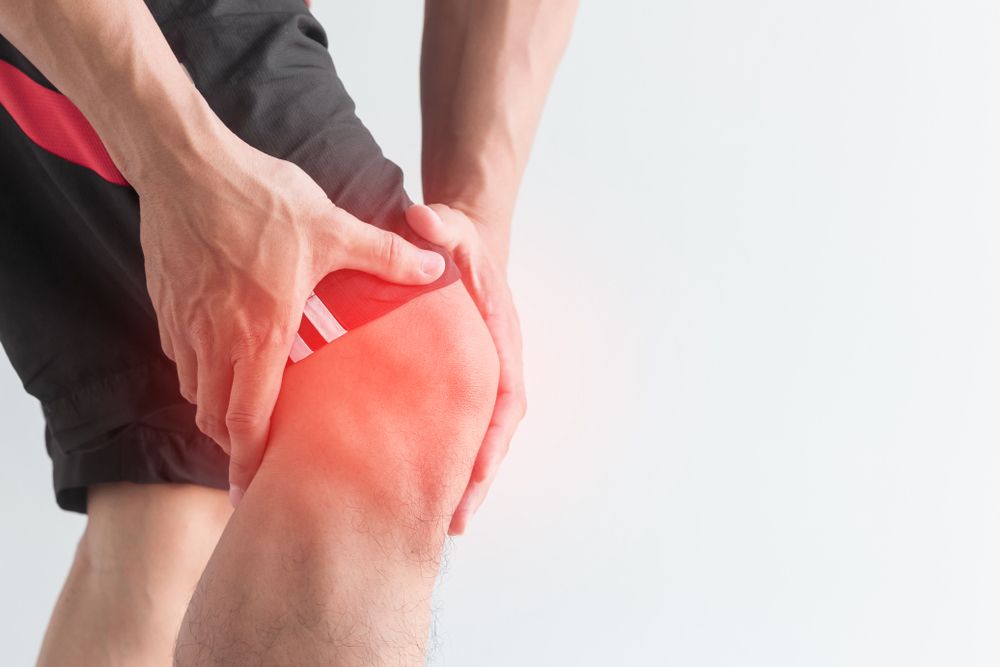This month we are going to focus our discussion on knee pain. A more sedentary lifestyle due to lockdown and a subsequent increase in bodyweight can be a contributing factor to knee pain. As the weather is now starting to pick up a little, we tend to see an influx of knee pain patients with more people starting to increase their running.
Lets start off with what structures are involved in the knee…
The knee is a hinge joint. The main two movements bending and straightening the knee (1). It is made up of 3 bones: the tibia, femur and the patella, more commonly known as the ‘kneecap’ (1). We have many ligaments, muscles that support the knee. You have probably most commonly heard of footballers adopting ACL injuries. Other structures involved are the meniscus (a fibrocartilage structure that acts as a shock absorber and increases the stability of the joint) (1). We also have several ‘bursae’ in the knee which is a fluid filled sac which aims to reduce friction. (1)
The knee is a load bearing joint. Factors such as age, weight, previous knee injuries and occupation/work that stresses the knee can pre-dispose you to knee pain (2). Did you know? When walking normally, approximately between 2-3x of your body weight goes through your knee (3). So weight management can be a good starting point for knee pain.
There are many different knee conditions that we see in clinic include: Osteoarthritis, ligament sprains, patellofemoral pain syndrome/anterior knee pain, meniscal tears, bursitis, tendinopathies, tendinitis. Now we are going to look into a couple of these in a little more detail.
Patellofemoral pain syndrome can sometimes be known as anterior knee pain, runners knee or jumpers knee(4). The pain is usually at the front of the knee, around the kneecap(4). It more commonly affects women than men(4). There are many factors that we consider in patients with patellofemoral pain including: kneecap misalignment/maltracking, weak hip muscles, tight/imbalance of hamstrings and foot posture(5). We aim to address most of these with physiotherapy intervention. Symptoms can include: a gradual onset of pain, increased pain with your usual everyday activities, pain when bending the knee i.e. climbing stairs, squatting, pain when sitting with your knee bent for a long time and clicking/popping/crackling on movement(4).
Osteoarthritis of the knee is basically thinning/wearing of the cartilage in your knee joint which can be seen on an X-ray (6).The cartilage aims to reduce friction and allows for smooth movement(6). Some people may have severe osteoarthritis with no pain and some people may have mild osteoarthritis with severe pain. Symptoms do not always correlate with what shows on an x-ray result. Although there is no cure for osteoarthritis, some are able to manage their symptoms well with correct and early intervention. Some symptoms may include: morning stiffness for no longer than 30 minutes, crunching/grating sounds in your knee, reduction in movement, the joint feeling stiffer generally and the knee looking more ‘knobbly’(7).
Strengthening the musculature around the knee joint including: quadriceps, hamstrings, gluteals, calves etc can help the knee becomes more stable and bones experience less impact during weight bearing, which can help to reduce pain(8). Exercise also helps to releases endorphins which can act as the body’s natural painkillers. (8) The NHS website has a knee exercises for runners here: https://www.nhs.uk/live-well/exercise/knee-exercises-for-runners/ (9).
Please note – this is not blog is not diagnostic, please seek medical advice if you are experiencing knee pain.
I hope you found May’s knee pain blog interesting and educational.
I hope to see you back here next month!
Georgia Smith
References:
- https://teachmeanatomy.info/lower-limb/joints/knee-joint/
- https://pubmed.ncbi.nlm.nih.gov/12479384/
- https://www.ncbi.nlm.nih.gov/pmc/articles/PMC3324308/
- https://my.clevelandclinic.org/health/diseases/17914-patellofemoral-pain-syndrome-pfps
- https://www.ncbi.nlm.nih.gov/pmc/articles/PMC4169618/
- https://www.arthritis-health.com/types/osteoarthritis/what-knee-osteoarthritis
- https://www.nhs.uk/conditions/osteoarthritis/symptoms/
- https://www.arthritis-health.com/treatment/exercise/knee-exercises-arthritis#:~:text=Pain%20reduction.,which%20in%20turn%20reduces%20pain
- https://www.nhs.uk/live-well/exercise/knee-exercises-for-runners/

